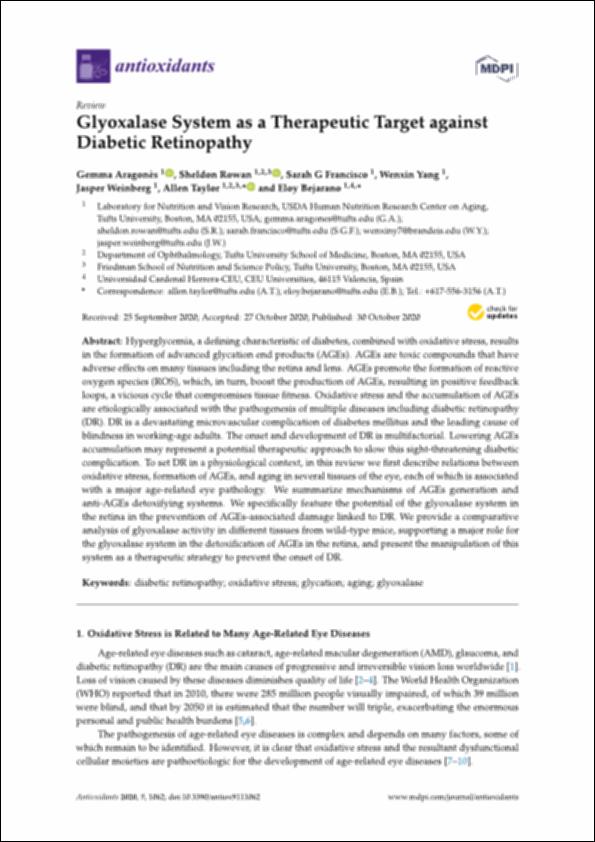Por favor, use este identificador para citar o enlazar este ítem:
http://hdl.handle.net/10637/12540Glyoxalase system as a therapeutic target against diabetic retinopathy
| Título : | Glyoxalase system as a therapeutic target against diabetic retinopathy |
| Autor : | Aragonès, Gemma Rowan, Sheldon Francisco, Sarah G. Yang, Wenxin Weinberg, Jasper Taylor, Allen Bejarano Fernández, Eloy |
| Materias: | Retinopatía diabética - Tratamiento.; Diabetic retinopathy - Treatment.; Estrés oxidativo.; Retina - Diseases - Treatment.; Envejecimiento.; Aging.; Retina - Enfermedades - Tratamiento.; Oxidative stress. |
| Editorial : | MDPI |
| Citación : | Aragonès, G., Rowan, S., G Francisco, S., Yang, W., Weinberg, J., Taylor, A., et al. (2020). Glyoxalase system as a therapeutic target against diabetic retinopathy. Antioxidants, vol. 9, i. 11 (30 oct.), art. 1062. DOI: https://doi.org/10.3390/antiox9111062 |
| Resumen : | Hyperglycemia, a defining characteristic of diabetes, combined with oxidative stress, results in the formation of advanced glycation end products (AGEs). AGEs are toxic compounds that have adverse e ects on many tissues including the retina and lens. AGEs promote the formation of reactive oxygen species (ROS), which, in turn, boost the production of AGEs, resulting in positive feedback loops, a vicious cycle that compromises tissue fitness. Oxidative stress and the accumulation of AGEs are etiologically associated with the pathogenesis of multiple diseases including diabetic retinopathy (DR). DR is a devastating microvascular complication of diabetes mellitus and the leading cause of blindness in working-age adults. The onset and development of DR is multifactorial. Lowering AGEs accumulation may represent a potential therapeutic approach to slow this sight-threatening diabetic complication. To set DR in a physiological context, in this review we first describe relations between oxidative stress, formation of AGEs, and aging in several tissues of the eye, each of which is associated with a major age-related eye pathology. We summarize mechanisms of AGEs generation and anti-AGEs detoxifying systems. We specifically feature the potential of the glyoxalase system in the retina in the prevention of AGEs-associated damage linked to DR. We provide a comparative analysis of glyoxalase activity in di erent tissues from wild-type mice, supporting a major role for the glyoxalase system in the detoxification of AGEs in the retina, and present the manipulation of this system as a therapeutic strategy to prevent the onset of DR. |
| Descripción : | Este artículo se encuentra disponible en la siguiente URL: https://www.mdpi.com/2076-3921/9/11/1062 Este artículo pertenece al número especial "Oxidative stress in diabetic retinopathy". |
| URI : | http://hdl.handle.net/10637/12540 |
| Derechos: | http://creativecommons.org/licenses/by/4.0/deed.es |
| ISSN : | 2076-3921 (Electrónico). |
| Fecha de publicación : | 30-oct-2020 |
| Centro : | Universidad Cardenal Herrera-CEU |
| Aparece en las colecciones: | Dpto. Ciencias Biomédicas |
Los ítems de DSpace están protegidos por copyright, con todos los derechos reservados, a menos que se indique lo contrario.


